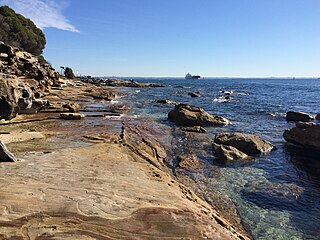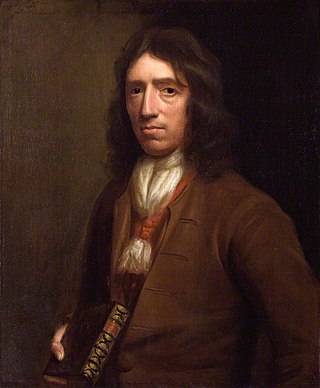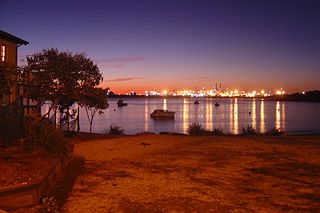
James Cook was a British explorer, navigator, cartographer, and captain in the British Royal Navy, famous for his three voyages between 1768 and 1779 in the Pacific Ocean and to New Zealand and Australia in particular. He made detailed maps of Newfoundland prior to making three voyages to the Pacific, during which he achieved the first recorded European contact with the eastern coastline of Australia and the Hawaiian Islands, and the first recorded circumnavigation of New Zealand.

The maritime European exploration of Australia consisted of several waves of European seafarers who sailed the edges of the Australian continent. Dutch navigators were the first Europeans known to have explored and mapped the Australian coastline. The first documented encounter was that of Dutch navigator Willem Janszoon, in 1606. Dutch seafarers also visited the west and north coasts of the continent, as did French explorers.

The Kamay Botany Bay National Park is a heritage-listed protected national park that is located in the Sydney metropolitan region of New South Wales, in eastern Australia. The 456-hectare (1,130-acre) national park is situated approximately 16 kilometres (9.9 mi) south-east of the Sydney central business district, on the northern and southern headlands of Botany Bay. The northern headland is at La Perouse and the southern headland is at Kurnell.

Possession Island is a small island in the Torres Strait Islands group off the coast of far northern Queensland, Australia. It is inhabited by a group of Torres Strait Islanders, the Kaurareg, though the Ankamuti were also indigenous to the island.

HMS Endeavour was a British Royal Navy research vessel that Lieutenant James Cook commanded to Australia and New Zealand on his first voyage of discovery from 1768 to 1771.

William Dampier was an English explorer, pirate, privateer, navigator, and naturalist who became the first Englishman to explore parts of what is today Australia, and the first person to circumnavigate the world three times. He has also been described as Australia's first natural historian, as well as one of the most important British explorers of the period between Francis Drake and James Cook, he "bridged those two eras" with a mix of piratical derring-do of the former and scientific inquiry of the later. His expeditions were among the first to identify and name a number of plants, animals, foods, and cooking techniques for a European audience; being among the first English writers to use words such as avocado, barbecue, and chopsticks. In describing the preparation of avocados, he was the first European to describe the making of guacamole, named the breadfruit plant, and made frequent documentation of the taste of numerous foods foreign to the European palate such as flamingo and manatee.

Botany Bay, an open oceanic embayment, is located in Sydney, New South Wales, Australia, 13 km (8 mi) south of the Sydney central business district. Its source is the confluence of the Georges River at Taren Point and the Cooks River at Kyeemagh, which flows 10 km (6 mi) to the east before meeting its mouth at the Tasman Sea, midpoint between the suburbs of La Perouse and Kurnell. The northern headland of the entrance to the bay from the Tasman Sea is Cape Banks and, on the southern side, the outer headland is Cape Solander and the inner headland is Sutherland Point.

Kurnell is a suburb in Sydney, in the state of New South Wales, Australia. It is 21.4 kilometres (13.3 mi) south of the Sydney central business district, in the local government area of the Sutherland Shire along the east coast. Cronulla and Woolooware are the only adjacent suburbs. La Perouse is located opposite, on the northern headland of Botany Bay. The Cronulla sand dunes are on the south eastern headland of Botany Bay. The eastern side of the peninsula is part of Botany Bay National Park, and Towra Point Nature Reserve is located on the western side of the suburb.

Port Botany is a suburb in south-eastern Sydney, in the state of New South Wales, Australia. Port Botany is located 12 kilometres south-east of the Sydney central business district, in the local government area of the City of Randwick. Port Botany sits on the northern shore of Botany Bay, adjacent to the suburbs of Matraville, Banksmeadow and Phillip Bay.

The bicentenary of Australia was celebrated in 1988. It marked 200 years since the arrival of the First Fleet of British convict ships at Sydney in 1788.

Point Danger is a headland, located at Coolangatta on the southern end of the Gold Coast on the east coast of Australia. Separated by Snapper Rocks and Rainbow Bay to the west, with Duranbah Beach and the Tweed River mouth to the south, present-day Point Danger has also indicated the border between New South Wales and Queensland, Australia, since 1863.
Point Hicks, is a coastal headland in the East Gippsland region of Victoria, Australia, located within the Croajingolong National Park. The point is marked by the Point Hicks Lighthouse that faces the Tasman Sea.

Captain Matthew Flinders was a British navigator and cartographer who led the first inshore circumnavigation of mainland Australia, then called New Holland. He is also credited as being the first person to utilise the name Australia to describe the entirety of that continent including Van Diemen's Land, a title he regarded as being "more agreeable to the ear" than previous names such as Terra Australis.

The Gweagal are a clan of the Dharawal people of Aboriginal Australians. Their descendants are traditional custodians of the southern geographic areas of Sydney, New South Wales, Australia.

The first voyage of James Cook was a combined Royal Navy and Royal Society expedition to the south Pacific Ocean aboard HMS Endeavour, from 1768 to 1771. It was the first of three Pacific voyages of which James Cook was the commander. The aims of this first expedition were to observe the 1769 transit of Venus across the Sun, and to seek evidence of the postulated Terra Australis Incognita or "undiscovered southern land".

Australia Day is the official national day of Australia. Observed annually on 26 January, it marks the 1788 landing of the First Fleet at Sydney Cove and raising of the Union Flag by Arthur Phillip following days of exploration of Port Jackson in New South Wales. In present-day Australia, celebrations aim to reflect the diverse society and landscape of the nation and are marked by community and family events, reflections on Australian history, official community awards and citizenship ceremonies welcoming new members of the Australian community.

The First Fleet Reenactment Voyage was a project to assemble a fleet of tall ships to sail from England to Australia in a historical reenactment of the First Fleet that colonised Australia in 1788. The reenactment was first conceived in 1977 and organised to commemorate Australia's bicentenary of colonisation. Despite opposition and minimal funding from the Australian government, the project attracted the support of high-profile adventurers Thor Heyerdahl, Alan Villiers, and Sir Edmund Hillary, as well as former Australian political figures and the British Royal Family. Several corporations offered to sponsor the fleet as a whole or individual ships, and additional money was raised by selling "training crew" berths for the various legs of the voyage.

The European exploration of Australia first began in February 1606, when Dutch navigator Willem Janszoon landed in Cape York Peninsula and on October that year when Spanish explorer Luís Vaz de Torres sailed through, and navigated, Torres Strait islands. Twenty-nine other Dutch navigators explored the western and southern coasts in the 17th century, and dubbed the continent New Holland.

The Gweagal shield is an Aboriginal Australian shield dropped by a Gweagal warrior opposing James Cook's landing party at Botany Bay on 29 April 1770. The shield was recovered by Joseph Banks and taken back to England, but it is unclear whether the shield still exists. An Aboriginal shield held by the British Museum, and once thought to be the Gweagal shield, is more likely to originate from an area further north. It is currently the subject of a campaign for its repatriation to Australia.

Silver Beach is a 2.8 km (1.7 mi) long west-trending sand spit in Kurnell, New South Wales located 18 km (11 mi) south of the Sydney CBD. Situated on the northwestern reaches of the Kurnell Peninsula and linked with the sandstone of Sutherland Point in the east, the beach is characterised by silver-coloured sands, hence the name, and fourteen rockwall groynes which project into Botany Bay. The eastern point of the beach is the site where Captain James Cook first set foot on Australian soil in 1770, which marked the beginning of Britain's interest in Australia and in the eventual colonisation of this new "southern continent".

















